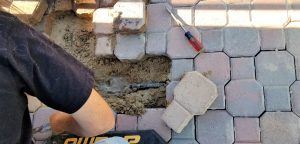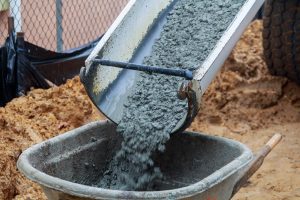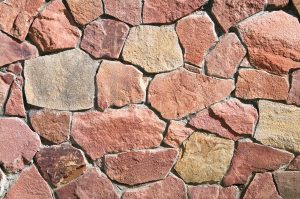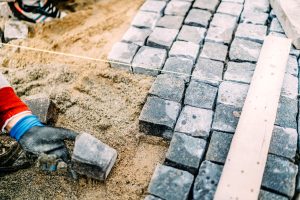Stone masonry-Uses, types, working, procedures
The building Construction of stones bonded together with mortar is termed stone masonry. Where the stones are available in an abundance in nature, on cutting and dressing to the proper shape, they provide an economical material for the construction of various building components such as walls, columns, footings, arches, beams.
Hence stone masonry being stronger, durable and weather-resistant as compared to brick masonry is used in the construction of piers, docks, dams lighthouses, and other marine structures.

Stone masonry is an ancient technique that has been in use since ancient times for constructing walls. The stones are cut into regular shapes before being arranged in a particular pattern or configuration.
The arrangement of stones in various patterns varies according to regional designs which could be traditional forms or modern designs depending upon the choice of the designer architect-engineer buyer.
The Technology employed for stone masonry is basically similar to that employed for bricks masonry excepting the materials involved are not composition made but are natural stones available in abundance. The stones are laid with the help of mortar which is a mixture of naturally occurring lime and aggregates such as sand, pebbles or broken stone.
At times soft stones like soapstone or soaprock are cut into regular shapes and then burnt in flames to make them tougher for structural purposes in specific gravity.
Stone masonry is widely used in the construction of low-rise buildings having single-storey structures or scattered individual structures with no connection between adjoining structures at all levels.
Stonemasonry alone cannot be used for constructing high rise buildings having more than one storey because it doesn’t provide stability through interlocking. In such cases steel rods are used to provide stability otherwise stone masonry might cause a collapse of the structure.

Stone masonry has found extensive use in the construction of residential buildings (apartment buildings, flats), commercial buildings (offices, showrooms), industrial structures (industrial units) which are generally single-storeyed or multi-stored, dams and bridges. Their exterior facades to are embellished with attractive stone masonry work using sandstones, granites, limestone etc.
Stone masonry types
The types of stones used in construction are based on building material and types of rocks(Igneous rocks, metamorphic rocks)There is two broad classifications of stone masonry based on the arrangement of stones in the construction and the degree of refinement in their surface finish. The types of stone masonry are:
Rubble Masonry
In the type of rubble masonry, we expect to find walls built with unhewn building blocks set together according to horizontal courses and bond stone in stone masonry by a fine mortar made from lime and sand particles mixed with water.
The fine mortar gives a smooth face to the wall and also fills small cracks between the stones and blocks even though they may not have been intended as part of the design process.

Sometimes cobbles were used as near-kindly, roughly shaped stones that had flat surfaces suitable for laying dry if no better block was available. The stones used in uncoursed rubble masonry are usually larger than those of ashlar, so making the edges of courses less regular and giving an unkempt feel to the wall.
Ashlar Masonry
In fine or coursed (coursed is one that has a consistent horizontal arrangement) masonry, the roughness of stone is disguised by cutting it into thin blocks whose thickness is slightly more than their width and length; this gives them straight flat faces with sharp edges at right angles to each other which make possible the exact dividing lines between courses.
These blocks were laid together carefully according to vertical courses, bonded by ‘squeezes’ (greasy mortar made from lime mortar mixed with sand particles), smoothed down and finally rubbed flat with a stone, this being the origin of the term ashlar.
Uses of Stone in building construction
Stone masonry is the craft of shaping rough pieces of rock into accurate geometrical shapes, mainly for architectural purposes. The stonework is usually built-in units or blocks which are held together by a mortar joint of cement and finely ground stone aggregate.
Building foundation, Stone masonry walls piers, pillars, and architectural work: A typical use of Stone Masonry. Stone masonry used to be a very popular form of construction in the early days especially because it provides a very good base.
Stone masonry can also provide a more aesthetically pleasing look compared to concrete slabs on top of steel beams from an architect’s perspective since they can be more creative with their designs when working with natural materials such as stones and rocks.
In addition, stones have been a known material for a long time and stone masonry units were constructed by the Romans in buildings such as their aqueducts or Roman Baths where stones of different shapes and sizes were used to create a magnificent sight.

Stone masonry is still used today, but not as much because there are more modern materials such as steel and concrete which provide strength without adding weight to the structures. Stone masonry was also used when constructing foundations for buildings due to the fact that it can bear heavy loads without having to add too much weight on top of it.
Stonework also provides an excellent view especially when they are placed at great heights where people who look up at them would be able to appreciate their beauty. Stonework has been widely used in modern times especially in Japan, where Stone masonry is used to decorate hotels and is also given as a gift by Japanese people who would want to express good wishes.
Stone work can be found in most places from gardens, temples, statues, theatres and bridges among others. Stone masonry has been used for centuries not only for building things but also as a medium of expression even before the 20th century where people began using it as a medium of art instead of just a construction material.
Working process of stone masonry
Stone masonry work is most often done by specially trained stonemasons. Stone blocks have been used in construction since ancient times, but since the nineteenth century, concrete blocks have become very common as well.
The vertical joints in each course brack with the adjoining course are at least 6 inches. If a stone is more or if the joints are broken after the mortar has been set, take the stone up and thoroughly clean the mortar from the bed and joints.
Whenever possible, properly point the face joints before the mortar sets. If joints cannot be the point, rake them out to a depth of 1 inch (25mm) before the mortar sets.
Do not smear the stone face surfaces with the mortar forced out of the joints of the mortar used in pointed. Drive the mortar firmly into the joint and wipe it off on both sides of each stone with a pointing trowel or flat side of a clean float.
Stone masonry work should be done only by good craftsmen who have been trained in sand-lime brickwork that is necessary for this type of work.

Procedures for the stone masonry construction
Do not smear the Stone face surfaces with the mortar forced out of the joints of the mortar used in pointed. Drive the mortar firmly into the joint and wipe it off on both sides of each Stone with a pointing trowel or flat side of a clean float. Stone masonry work should be done only by good craftsmen who have been trained in sand-lime brickwork which is fine-grained is necessary for this type of work.
A Stone’s surface may be roughened slightly with coarse any, to improve adhesion between Stones used in construction and mortar, especially if washed with water before applying mortar. The stone must be kept dry until right after pointing.
The vertical joints in each course brack with the adjoining course are at least 6 inches. Stone masonry work should be done only by good craftsmen who have been trained in sand-lime brickwork that is necessary for this type of work.
Whenever possible, properly point the face joints before the mortar sets. If joints cannot be the point, rake them out to a depth of 1 inch (25mm) before the mortar sets. Stone masonry work should be done only by good craftsmen who have been trained in sand-lime brickwork that is necessary for this type of work.
The Stone should never touch other Stone at any other Stone’s surface may be roughened slightly with coarse any, to improve adhesion between Stone and mortar, especially if washed with water before applying mortar. The Stone must be kept dry until the right
Stone masonry work should be done only by good craftsmen who have been trained in sand-lime brickwork that is necessary for this type of building Stone.









